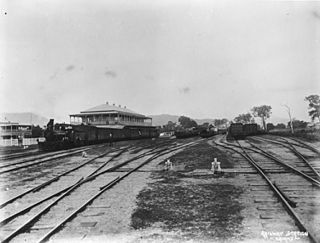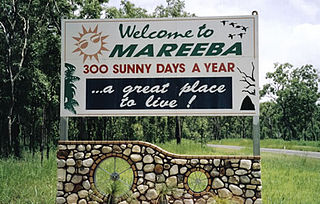
No. 1 Scottish Gympie Mine and Battery is a heritage-listed mine at Old Brisbane Road, Monkland, Gympie Region, Queensland, Australia. It was built from c. 1889 to c. 1923. It was added to the Queensland Heritage Register on 21 October 1992.

Wenlock Goldfield is a heritage-listed mine in Archer River, Shire of Cook, Queensland, Australia. It was built from 1892 to 1950s. It is also known as Batavia Goldfield and Lower Camp (Wenlock). It was added to the Queensland Heritage Register on 3 March 2006.

Alexandra Mine and Battery is a heritage-listed mine at Palmerville Station, Maytown, Shire of Cook, Queensland, Australia. It was built from c. 1878 to 1898. It is also known as Alexandra PC.It was added to the Queensland Heritage Register on 21 October 1992.

Gordon's Mine and Mill is a heritage-listed mine at Iron Range, Shire of Cook, Queensland, Australia. It was built from c. 1936 to 1950s. It is also known as Iron Range Mine and Mill. It was added to the Queensland Heritage Register on 13 December 2002.
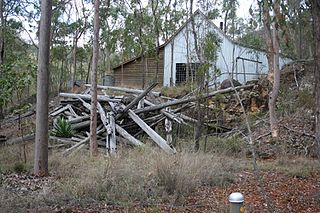
Great Northern Mine is a heritage-listed mine off Jacks Road, Herberton, Tablelands Region, Queensland, Australia. It was built from 1880 to 1940s. It was added to the Queensland Heritage Register on 21 October 1992.

Anglo Saxon Mine is a heritage-listed mining camp at Groganville, Shire of Mareeba, Queensland, Australia. It was built from 1886 to 1897. It is also known as Groganville Township and Limestone Cemetery. It was added to the Queensland Heritage Register on 3 October 2003.

OK Mine & Smelter is a heritage-listed mine at Kitoba Holding, Bellevue, Shire of Mareeba, Queensland, Australia. It was built from 1902 to 1942. It was added to the Queensland Heritage Register on 2 October 1996.
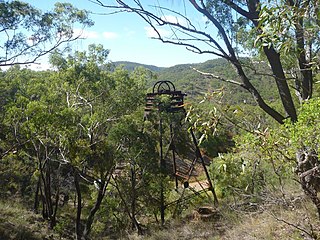
Vulcan Mine is a heritage-listed former mine at Mareeba Mining District, Irvinebank, Shire of Mareeba, Queensland, Australia. It was built from c. 1889 to 1930s. It was added to the Queensland Heritage Register on 21 October 1992.

Kingsborough Battery is a heritage-listed mining building off the former East Street, Kingsborough, Thornborough, Shire of Mareeba, Queensland, Australia. It was built from c. 1896 to 1990s. It was added to the Queensland Heritage Register on 21 October 1992.
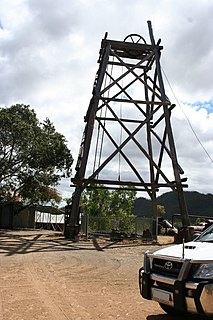
Tyrconnel Mine and Battery is a heritage-listed mine between Kingsborough and Thornborough, Shire of Mareeba, Queensland, Australia. It was built from 1876 to 1980s. It was added to the Queensland Heritage Register on 21 October 1992.
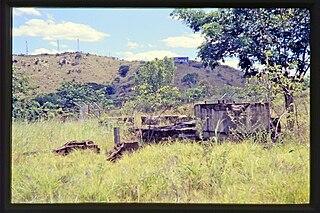
Day Dawn mine remains is a heritage-listed mine ruins at Paull Street, Charters Towers, Charters Towers Region, Queensland, Australia. It was built from 1891 to 1913. It was added to the Queensland Heritage Register on 29 April 2003.

Aspasia Mine and Battery is a heritage-listed mine and stamper battery at Gulf Developmental Road, Georgetown, Shire of Etheridge, Queensland, Australia. It was built from 1916 to 1952. It is also known as Mount Turner Battery. It was added to the Queensland Heritage Register on 13 April 2006.

Joseph Morris Mine is a heritage-listed former mine at Georgetown Mining District, Gilberton, Shire of Etheridge, Queensland, Australia. It was built from 1903 to 1910. It was added to the Queensland Heritage Register on 5 April 2004.

Content Mine is a heritage-listed former mine at Gulf Developmental Road, Croydon, Shire of Croydon, Queensland, Australia. It was built from 1887 to 1918. It is also known as Content Block Mine. It was added to the Queensland Heritage Register on 4 July 2006.

Homeward Bound Battery and Dam is a heritage-listed stamping mill and reservoir at Croydon, Shire of Croydon, Queensland, Australia. It was built in 1888 by Mr Schumacher. It was added to the Queensland Heritage Register on 21 October 1992.

Richmond Mine and Battery is a heritage-listed mine at Gulf Developmental Road, Croydon, Shire of Croydon, Queensland, Australia. It operated from 1886 to c. 1916. It was added to the Queensland Heritage Register on 28 July 2006.

Golden Gate Mining and Town Complex is a heritage-listed mining camp at Normanton Road, Croydon, Shire of Croydon, Queensland, Australia. It commenced in 1886. It is also known as Golden Gate Township, Croydon Consols Pump Shaft, Golden Gate No.10 North Mine, Golden Gate Cemetery, Croydon Consols Battery and Cyanide Plant, and Golden Gate Mine. It was added to the Queensland Heritage Register on 14 August 2009.

Mount Isa Mine Early Infrastructure is a heritage-listed group of mining infrastructure on the Mount Isa Mine Lease, Mount Isa, City of Mount Isa, Queensland, Australia. They comprise the Lawlor Shaft & Winding Plant, the Urquhart Shaft and Headframe, the Mount Isa Mine Experimental Dam, and the Mount Isa Mine Power Station. They were built from 1924 to c. 1963. They were added to the Queensland Heritage Register on 25 February 2005.








